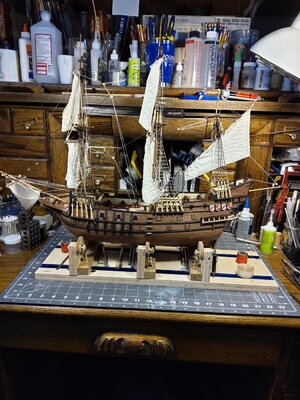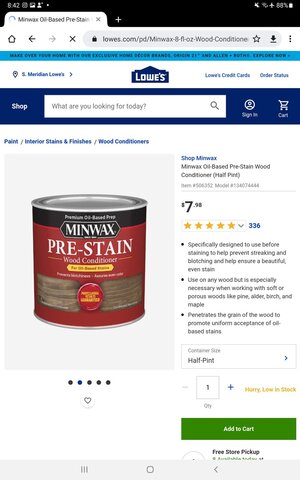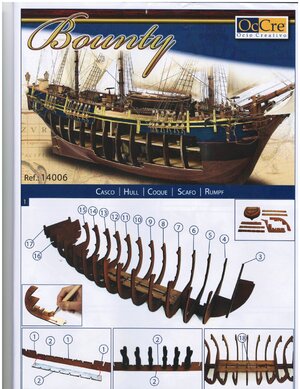I have started the Occre HMS Bounty. The bulkheads and keel (and other parts) require staining. The appearance is important because the side of the ship is open for viewing. The bulkheads appear to be birch, which stains poorly. My efforts and have been blotchy and amateurish. I have tried regular stain, gel stain, wood conditioner, and combinations of these. I've also tried wood dye. The grain of this wood still comes out splotchy and I believe even if I got it perfect, the grain would look terribly out-of-scale and unacceptable. Any thoughts?
-

Win a Free Custom Engraved Brass Coin!!!
As a way to introduce our brass coins to the community, we will raffle off a free coin during the month of August. Follow link ABOVE for instructions for entering.
You are using an out of date browser. It may not display this or other websites correctly.
You should upgrade or use an alternative browser.
You should upgrade or use an alternative browser.
Phil, this is the exact product I used. In my latest effort I applied it at three separate intervals, then used gel stain. So far this is my best effort.
Jim
Jim
Gel stain - wipe on, wipe off? You can always try using shellac as a base coat before applying a finish too. Always try it on similar scrap before committing to your project. I personally like using sanding sealer or brushing lacquer.
I just thought I'd add what I've found on the sapele deck planks on my San Francisco. I found this by accident, since I was impatient and didn't want to wait for delivery. I went into a local model shop that doesn't specialise in wooden models. I bought Humbrol clear satin aqueous varnish.
It turns out that time-saving went right out of the window. After testing on a little test piece of veneer added to a scrap of ply, I found that 3 or 4 coats were needed, sanding with fine wet and dry after the second coat and buffing with 0000 wire wool after the final coat. The result is a lovely satin (I didn't want glossy) and the grain is evenly coloured.
What wood is the bulkhead and keel? So far my Humbrol varnish has worked well on mahogany, applewood and sapele. It takes a lot of work, though.
It emphasises the grain, but doesn't darken it too much. I love the result.
I guess this isn't much use if you need a stain, but do you? Can the wood not be lighter? I suppose only you'll know that.
It turns out that time-saving went right out of the window. After testing on a little test piece of veneer added to a scrap of ply, I found that 3 or 4 coats were needed, sanding with fine wet and dry after the second coat and buffing with 0000 wire wool after the final coat. The result is a lovely satin (I didn't want glossy) and the grain is evenly coloured.
What wood is the bulkhead and keel? So far my Humbrol varnish has worked well on mahogany, applewood and sapele. It takes a lot of work, though.
It emphasises the grain, but doesn't darken it too much. I love the result.
I guess this isn't much use if you need a stain, but do you? Can the wood not be lighter? I suppose only you'll know that.
When I built the SFO II, the bulkheads were internal and were birch plywood, as was the keel. I covered the keel with Sapele (5mm x .0.5mm). No birch was left exposed....I just thought I'd add what I've found on the sapele deck planks on my San Francisco. I found this by accident, since I was impatient and didn't want to wait for delivery. I went into a local model shop that doesn't specialise in wooden models. I bought Humbrol clear satin aqueous varnish.
It turns out that time-saving went right out of the window. After testing on a little test piece of veneer added to a scrap of ply, I found that 3 or 4 coats were needed, sanding with fine wet and dry after the second coat and buffing with 0000 wire wool after the final coat. The result is a lovely satin (I didn't want glossy) and the grain is evenly coloured.
What wood is the bulkhead and keel? So far my Humbrol varnish has worked well on mahogany, applewood and sapele. It takes a lot of work, though.
It emphasises the grain, but doesn't darken it too much. I love the result.
I guess this isn't much use if you need a stain, but do you? Can the wood not be lighter? I suppose only you'll know that.

Phil, I believe the bulkheads are birch. Your cures sound like the long way around but at this juncture I am more than willing to try anything. The birch is nasty stuff and I've pretty much ruined the bulkheads. I think Occre will send replacements. I will try what you've suggested and hope for the best.
Thanks, Jim
Thanks, Jim
I'm missing something. Are you building to allow the interior to be shown? If that is the case, I'd certainly consider planking the bulkheads instead of some other finish.Phil, I believe the bulkheads are birch. Your cures sound like the long way around but at this juncture I am more than willing to try anything. The birch is nasty stuff and I've pretty much ruined the bulkheads. I think Occre will send replacements. I will try what you've suggested and hope for the best.
Thanks, Jim
Just another thought about this.
If you used white carpenters wood glue and didn't clean off the excess, it will be painfully obvious when you stain the wood.
If you used white carpenters wood glue and didn't clean off the excess, it will be painfully obvious when you stain the wood.
I'm missing something. Are you building to allow the interior to be shown? If that is the case, I'd certainly consider planking the bulkheads instead of some other finish.
Phil, this is what I'm working with.
I see now. My apologies! I guess if I were at this point with the bulkheads, I might just go with a suitable paint.... I'm sure you'll get it figured out.Phil, this is what I'm working with.
The edges on the plywood frames could be covered with a strip of mahogany or other suitable hardwood so you don't see the laminations. Plywood is often coarse in grain and rarely takes a stain with good results. Laminating with a quality veneer looks much better. It would be more work to laminate the sides and cut those complicated profiles out. Phil's comment about paint seems the easiest solution, and adding a nice, stained veneer to the edge could be an accent that draws the eye away from the interior frame surfaces.
I'm building an interior. I've bought mahogany and sapele strips for the ply and decks that I'm adding. That warning about carpenter's glue is well worth noting. I thought I'd been extremely careful, wiping off any excess, but there were still a few patches that took ages to eliminate. I'm carving out the bulkheads and adding reinforcements that are more in keeping with the original structure. It's a ton of work but will hopefully be worthwhile.
You are starting the same interior rebuild I am in the middle of performing on HMS Sovereign of the Seas. Check my build log. You may find some methods useful for removing the original frames and replacing the interior support structure with a more accurate one. And yes, the final result will be worth all the extra work. Look at it as an educational opportunity for learning the interior structure of a wooden ship.I'm building an interior. I've bought mahogany and sapele strips for the ply and decks that I'm adding. That warning about carpenter's glue is well worth noting. I thought I'd been extremely careful, wiping off any excess, but there were still a few patches that took ages to eliminate. I'm carving out the bulkheads and adding reinforcements that are more in keeping with the original structure. It's a ton of work but will hopefully be worthwhile.
Last edited:
I'll certainly take a look at that. Thanks. Already, with just a few added deck sections and the working whipstaff steering for the helmsman, it looks so much better. I've got my nano LED lights (amber/yellow) and I'm making lanterns. It is an education, but one I'm enjoying. I've spent hours digging into the details of these ships with help from others on this forum. I don't regret a minute of it. I'm dying to start adding guns, rigging and the rest, but I need to get the basics right first.You are starting the same interior rebuild I am in the middle of performing on HMS Sovereign of the Seas. Check my build log. You may find some methods useful for removing the original frames and replacing the interior support structure with a more accurate one. And yes, the final result will be worth all the extra work. Look at it as an educational opportunity for learning the interior structure of a wooden ship.
- Joined
- Dec 30, 2021
- Messages
- 5
- Points
- 3

Hoe about Tung oil or Danish oil? Anyone any experience. I wanted to use the latter. IT seems a single later will be sufficient.
We were talking about the protection of the timbers on the actual ship, and the color that the model would be as a result. However, Danish oil seems to create the most attractive wood finished on a model, provided all course scratches in the wood are properly sanded out. All the grain shows. Danish oil does not seal the wood like tung oil, but lets moisture in and out similar to linseed oil. Tung oil will seal the pores of the wood, given a few coats. It tends to be gummy unless you apply thin coats and let dry in between. It is used as wood preservative in real marine environments on boats even today. I prefer Danish oil as a stain on a model. Given enough coats, tung oil will make the wood glossy. Some people varnish their model until it is very glossy, as if it were dipped in glass. To me, that looks ugly and certainly unrealistic. A satin finish is the most glossiness that wood should have if your aim is for realism.Hoe about Tung oil or Danish oil? Anyone any experience. I wanted to use the latter. IT seems a single later will be sufficient.








